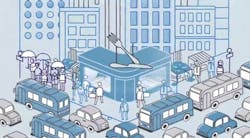10 U.S. cities with the best urban forests
The benefits of having abundant and well-planned green spaces in urban areas goes beyond aesthetics. Parks, landscaping, planters, tree-lined streets, and urban forests also translate to increased property value, lower energy costs, and more revenue for the city.
For instance, officials with the city of Denver claim that as much as $18 million of the city's annual tourism revenue can be attributed to its parks system. The city of Charlotte estimates that it's tree-lined streets provide more than $900,000 in energy savings per year. And Milwaukee’s urban forest helps remove 496 tons of pollution annually.
All three metros were ranked recently as best U.S. cities for urban forests by the conservation organization American Forests, in a project funded by the U.S. Forest Service. As part of the study, American Forests worked with a panel of urban forest experts to evaluate the nation's 50 most populous cities based on:
- Civic engagement in maintaining the urban forest
- Urban forest strategies and city greening to address city infrastructure challenges
- Accessibility of urban forest and greenspaces to the public
- Overall health and condition of the city’s urban forest
- Documented knowledge about its urban forests
- Urban forest management plans and management activities.
Based on their research, American Forests assembled a list of the top 10 cities for urban forests:
Austin, Texas — 18% of city is parkland; diverse tree canopy; urban forest management plan in place
Charlotte, N.C. — has several recreation attractions, including the U.S. National Whitewater Center and a pocket park known as The Green; strong comprehensive management plans; tree ordinances designed to protect both public and private trees; public-private initiative, TreesCharlotte, to plant trees on private property.
Denver — requires developers to diversify tree species during plantings; developed city-wide planting and canopy goals; keeps records of the age distribution of the canopy; major attractions include the Denver Botanic Gardens, with more than 32,000 species of plants, and the City Park Arboretum, with more than 3,000 trees.
Milwaukee — home to Wisconsin’s only urban state park, Lakeshore State Park; has 25 acres of park per 1,000 residents; urban forest provides $15 million in stormwater savings and removes 496 tons of pollution annually; keeps comprehensive inventory of trees; implemented diversification plans.
Minneapolis — a park every six blocks, including some designed for off-road cycling, hiking, canoeing and swimming; tree canopy of 31 percent, only 6.5 percent shy of its potential canopy of 37.5 percent; one of the first cities to use the U.S. Forest Service’s iTree assessment tool to determine the benefits of its urban forest.
New York — 19.5% of city is parkland; five trees per acre for a canopy of 21 percent; series of management plans, including several that focus on wetlands and green infrastructure; mayor has set goal of planting one million new trees by 2017
Portland, Ore. — main attractions include a 5,000-plus-acre park with 70 miles of trails and an arboretum with nearly 1,000 species of trees and shrubs; goals for the city’s canopy are built into multiple management plans; city is using green infrastructure as a cost-effective alternative to gray infrastructure; protecting its trees through public and private ordinances and a diversification strategy; estimates that its street trees alone have added more than $13 million in property resale value.
Sacramento, Calif. — main attractions include a 33-mile bike trail and the picturesque Capitol Park surrounding California’s State Capitol, which features 450 varieties of trees and flowering shrubs; recently completed a best management practices study; has a strong volunteer base; each year, one of the city’s electric utilities and a nonprofit partner to plant 13,000 trees on private property that will provide shade to homes and reduce energy demand.
Seattle — recently completed an iTree analysis and Interactive Habitat Map, designed to let urban forestry team members know not only where trees can be planted, but also what kind of species would be most desirable; features an old-growth forest and a former crude oil plant location turned into a park; city's 4.35 million trees are estimated to be worth about $4.9 billion.
Washington, D.C. — the National Mall and its monuments and memorials feature 17,000 trees; the District also houses the nation’s first urban park, Rock Creek Park, as part of its more than 7,000 acres of parkland and has two major rivers within its city limits.
For more on the top 10, visit: http://www.americanforests.org/our-programs/urbanforests/10-best-cities-for-urban-forests.
